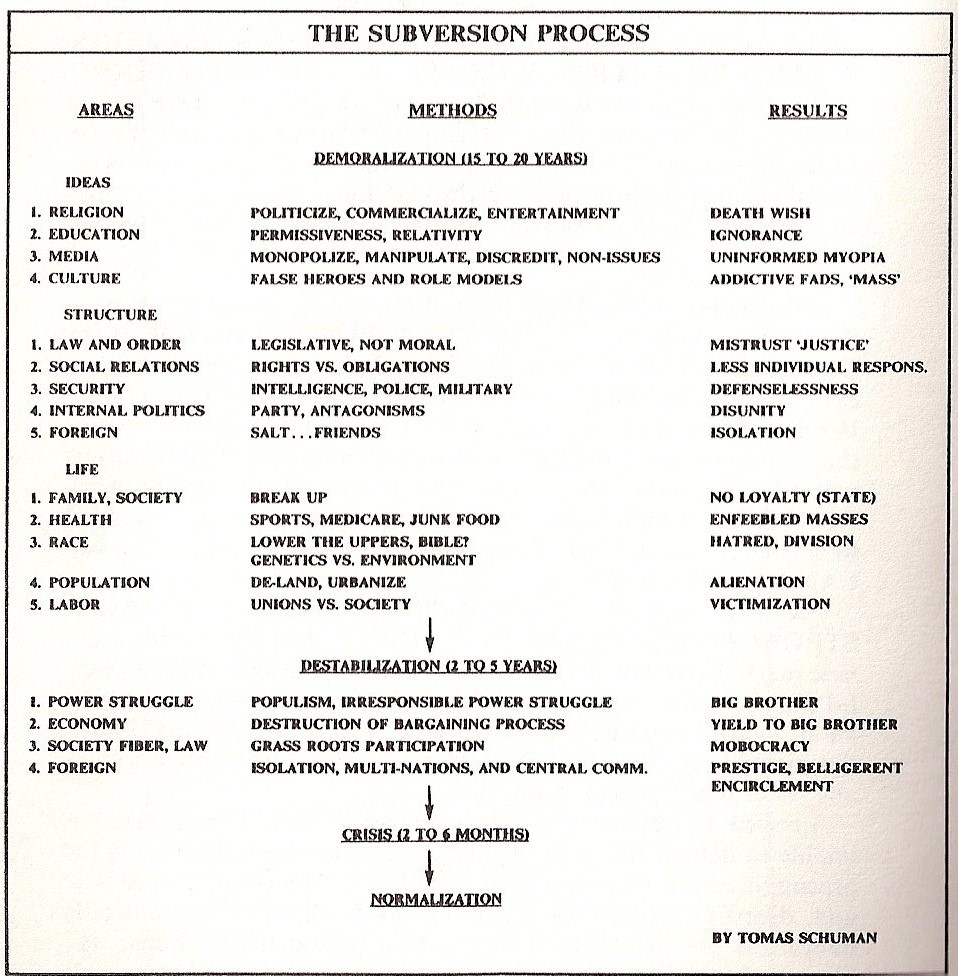Hypernormalization in Hollywood
Posted By Anthony Bavaria On In North American New Right | Comments DisabledI came across David Cronenberg’s Videodrome relatively late in my arc of movie-viewing enthusiasm. It went well past the high school-aged fascination with low-brow horror (the original Friday the 13th or Nightmare on Elm Street) or college-years serial killer obsession (American Psycho or any movie derived from Ed Gein mayhem). In fact, viewing Cronenberg’s archetypal body horror film fit squarely in my mid-twenties’ avant-garde/auteur interest phase (anything ranging from the French New Wave to repetitive Wes Anderson films), so in a sense, I saw it right when I was supposed to. I was about 25; it was 2011, 28 years after the movie first debuted.
Given the sociocultural zeitgeist of the era in which I viewed it, the film’s plot was almost laughable: A television station president uncovers a Right-wing conspiracy to use mass media to control their viewership’s minds. I played devil’s advocate with myself, remembering that the film was made during the then seemingly infinite upward slant of Reagan-era conservatism (even though the film’s writer/director is Canadian), and maybe this plot was a satire on this. But this was the same decade that produced big-budget and avant-garde polemics against all things seemingly conservative — well, 1980s mainstream conservatism, at least — such as war (Platoon), authoritarianism and industrialization (Brazil), and techno-capital (Blade Runner).
Regardless of Videodrome’s bait-and-switching the ideological origins of media-based social engineering, I still loved the movie, so more devil’s advocating ensued. The conspiracists in the film were using mass media to subvert the masses in order to rid the West of its decadence and weaknesses. Okay, I’d heard about vaguely similar conspiracies of the era: My African-American barber told me how the music industry promoted gangsta-rap and all its associated lyrics of killing, drug use, and demeaning women to keep the black population marginalized (did my barber know what ethno-religious identity group is overrepresented in the music industry’s top rungs?); or the subversive nature of television advertising and product placement to get viewers to buy more crap they don’t need. Putting down black people and promoting capitalism certainly seemed conservative from a normie Leftist point of view, but I still couldn’t shake the notion of a Right-wing agenda in entertainment as completely exaggerated.
Outside of AM talk radio, Conservative Inc. institutions such as FOX (neo-cons, none of whom are really concerned about conserving anything), and watered-down civ-nat online-only institutions like Breitbart, what authentically conservative mass media institutions actually exist? And those are merely news outlets. What about specifically entertainment-based media? To further elaborate, compared to modern-day anarcho-socialist agit-prop blockbusters like Elysium and V for Vendetta — with budgets in the vicinity of $115 million and $50 million, respectively –, where does conservative entertainment-based mass media fall on the funding scale? By the way, those are just two movies – which had a combined profit of over $400 million.[1] [2]
Some critics claim — not completely without merit — that Hollywood is actually more conservative than one would think. The best example of this vein of critique is Matthew Alford’s Reel Power: Hollywood Cinema and American Supremacy. Though Alford accurately highlights Hollywood’s favorable views of American interventions abroad and promotion of militarism in general, especially as something ostensibly conservative, he fails to, first, adequately explain that neoconservatism is not at all actually conservative (already mentioned above), and second, that it routinely anchors on depictions of modern Right-wing foreign policies while ignoring Left-wing socio-cultural issues. For example, in the book’s Forward, Michael Parenti writes that“[a]lso easily overlooked is the fact that Hollywood operates within fixed ideological parameters,” and that “the film industry is also a culture industry. . . . So while the prime goal is big profits for the major studios, another goal, whether explicitly acknowledged or not, is ideological control.”[2] [3] It takes no great stretch of the imagination to realize that Hollywood might be applying their “culture industry” and “ideological control” to things other than a positive attitude toward an aggressive American foreign policy; which just so happened to be crafted by the policymakers that “mistook Tel Aviv for the capital of the United States.”[3] [4]
This leads us to those sociocultural issues mentioned above. The subversion in Left-wing entertainment is blatant and boils down to classic Soviet or Sino-Communist tactics: Do something unethical and then accuse your opposition of doing exactly what you just did. Any entertainment-based media depicting modern media as having a conservative spin is therefore, as stated above, laughable.
Since authentically conservative control of entertainment media is almost non-existent today, Hollywood frequently has to reach back in time to show this — usually to the same event. To this day, they lionize the victims of the House Un-American Activities Committee (HUAC) and their state-sponsored censorship of Communist sympathizers and agitators in the 1950s. Hollywood loves being the victim so much that they make a film about it every few years: Good Night, and Good Luck; The Front; Guilty by Suspicion; One of the Hollywood Ten; and The Way We Were — not to mention countless documentaries.[4] [5] Alford’s book actually pays homage to the Hollywood blacklist not only on its first page, but in its first paragraph.[5] [6] However, filmmakers were targeted over 70 years ago; they’ve been doing the targeting themselves for some time since then. The fact that it’s corporate-sponsored vice state-sponsored seemingly makes it okay in the eyes of the current culture-shapers. Government totalitarianism is unacceptable, but private totalitarianism is just fine, apparently.
This accuse-your-foe-of-exactly-what-you’re-doing tactic has been accelerated in recent years. Some wavetop bait-and-switch examples are Steig Larsson’s The Girl With the Dragon Tattoo and David Fincher’s subsequent film adaptation, a story about a white male Swede systematically raping and killing immigrant women in a country whose sexual assault cases are overwhelmingly committed by immigrant men against Swedish women[6] [7] [7] [8] (so much so that in order to fix the embarrassing problem, the zealots of Swedish multiculturalism merely stopped reporting the ethnicity of sexual assault perpetrators);[8] [9] or Zack Snyder’s Justice League, featuring a fear-riddled post-Superman world where a skinhead berates a burqa-clad female store owner, shot in beautiful slow motion, and a group of “reactionary terrorists” — all white, of course — plot to blow up a section of London. Unfortunately, your average Londoner should be able to tell you that terrorist attacks on their city in the past 20 years have been disproportionately committed by the exact people portrayed as innocents against those portrayed as evil at the beginning of the film.[9] [10] And by the way, Justice League had a budget of $300 million and a domestic box office of over $650 million.[10] [11]
My personal favorite is an action-packed film about an attack on Manhattan’s financial district. Its 1995 debut was sandwiched between two attacks on the same real estate (the 1993 and 2001 World Trade Center attacks), both carried out by Middle Eastern terrorists; but who are the villains in Die Hard with a Vengeance? Neo-Nazis, of course. This would be an eye-roll in and of itself, but the fact that both Islamic extremist-perpetrated attacks in New York were the result of America’s geopolitical cahooting with Israel makes it beyond ironic. The same Nazi plant happened in the film adaptation of Tom Clancy’s The Sum of All Fears: Islamic terrorist organizations — which exist in real life — are magically replaced by monied neo-Nazi groups with massive power at their disposal. Is anyone aware of an outfit like this in modern times?
 [12]
[12]You can buy Greg Johnson’s The Year America Died here. [13]
Since superhero movies have been touched on, it’s worth coming back to the promotion of militarism on the silver screen, because they absolutely do this. But if that is the real message, why is it so obvious? True messages and meanings are usually hidden beneath the surface. In Zack Snyder’s Man of Steel, the constant insistence on accepting the “alien” Superman into society and ousting the diabolical villain who is trying to “protect his people” is certainly a layer or two beneath all those A-10 Warthog strafings and F-35 Lightning II missile launches. If anything, this militaristic point of view actually projects an alliance between governments and their armed forces and the far-Left message, merely a few levels deeper.
Why is the exact opposite of what is actually happening being portrayed — in an entertaining fashion — using billions of dollars in funding and reaping even more billions in profits? It almost seems as if an alternate reality is being crafted for public consumption: a world many people believe in and take at face value, but which others know to be fake.
The key to understanding this paradox lies in anthropology professor Alexei Yurchak’s term: hypernormalization. Originally coined to describe the fakeness of mid-to-late-era Soviet society and the people’s eventual acceptance of this fakeness, hypernormalization can be used more broadly to describe the process — usually backed by a massive institution, like a government or media conglomerate — of making a false and baseless narrative real.[11] [14] Yurchak highlights that the linguistics of hypernormalized propaganda becomes an end in itself, eerily echoing the West’s current condition:
Although any authoritative language, political or religious, contains many formulaic structures, clichéd “sound bites,” and ritualized features — and is therefore highly citational — the new authoritative language of late socialism had acquired certain unique characteristics. This language had become what I term hypernormalized — that is, the process of its normalization did not simply affect all levels of linguistic, textual, and narrative structure but also became an end in itself, resulting in fixed and cumbersome forms of language that were often neither interpreted nor easily interpretable at the level of constative meaning. This shift to the hypernormalized language in which the constative dimension was increasingly being unanchored is key for our understanding of late socialism.[12] [15]
The term has since gained more prominence when it was explored by one of the very few “conspiracy theorists” who has gained mainstream acceptance: Adam Curtis, in his documentary HyperNormalisation.
Another Eastern Bloc dissident to examine this notion was Soviet defector Yuri Bezmenov. Writing under the pen name Tomas Schuman, Bezmenov used what he had learned while employed as a Soviet propagandist and KGB informant to write his book Love Letter to America about Soviet-style subversion, particularly as it was aimed at the West. Though I won’t go into detail, his words on media manipulation dovetail with the normalization of “non-issues” as portrayed in the movies referenced above, resulting in an “uninformed myopia.”[13] [16] The key is in Bezmenov’s last step, which perfectly aligns with Yurchak’s work: “normalization.”[14] [17]
Renewed interest in Bezmenov in recent years has helped shed new light on the idea of subversion in the media, but it is nowhere near enough. Counter-Currents writer Beau Albrecht sums up Bezmenov’s work on subversion more generally when he states, “Marxists did, and still do, have considerable faith in social engineering, something they consider to be like a science. By nudging the masses in a certain direction at the right time, the theory goes that the central planners will be able to shape society however they want.”[15] [19]
Insert your Orwellian nightmare reference of choice here to truly grasp what is required to make the process of hypernormalization work: revising or outright erasing history, inventing new terms, banishing old ones, taking the voice of certain groups of people away, and so on. How is all of this achieved? Making billion-dollar films where you literally show your moral or ideological opposition doing exactly what you’re doing is certainly one way. Are non-whites attacking London? Show whites as the bad guys! Are immigrant men raping native Swedes? Show Swedish men doing it! Does the Left have an inordinate influence in entertainment? Critique it for being too conservative!
To understand this madness, I must quote a madman:
Generally speaking, the goals of today’s leftists are NOT in conflict with the accepted morality. On the contrary, the left takes an accepted moral principle, adopts it as its own, and then accuses mainstream society of violating that principle.[16] [20]
Though the examples of media subversion in this piece are more than likely nothing revelatory to the average Counter-Currents reader, laying out the architecture and understanding the ideological framework behind them is key.
Unfortunately, the Dissident Right is a non-player in terms of institutional control in this or any other country in the West, but this presents us with an opportunity to be avant-gardists ourselves. Counter-Currents is a textbook example on the intellectual front, but an equal effort must be made in the arts — something beyond witty memes, though they are obviously essential. Fortunately, there seems to be a surge of dissident fiction writers, cartoonists, and traditional artists taking up the cause. Though the Dissident Right is a long way off from mass-scale hypernormalization of a set of ideas that, first, most of society doesn’t know about, and second, that are lampooned and demonized on every front at all times, we can start by normalizing the type of discourse and content within our own circles. Intellectually sound and artistically original works are certainly a good standard to set.
The white pill comes at the end. No matter how hypernormalized the fakeness of Soviet society became for its populace, the average citizen knew it was bullshit, and one day it came to an end. The prefabricated cultural norms that Hollywood spends billions on projecting will also come to an end; the only question is how much damage it will cause before it has run its course.
In the meantime, for those of us on the Dissident Right, merely knowing what’s going on is enough.
* * *
Counter-Currents has extended special privileges to those who donate $120 or more per year.
- First, donor comments will appear immediately instead of waiting in a moderation queue. (People who abuse this privilege will lose it.)
- Second, donors will have immediate access to all Counter-Currents posts. Non-donors will find that one post a day, five posts a week will be behind a “paywall” and will be available to the general public after 30 days.
To get full access to all content behind the paywall, sign up here:
Paywall Gift Subscriptions
 [21]If you are already behind the paywall and want to share the benefits, Counter-Currents also offers paywall gift subscriptions. We need just five things from you:
[21]If you are already behind the paywall and want to share the benefits, Counter-Currents also offers paywall gift subscriptions. We need just five things from you:
- your payment
- the recipient’s name
- the recipient’s email address
- your name
- your email address
To register, just fill out this form and we will walk you through the payment and registration process. There are a number of different payment options.
Notes
[1] [22] The Numbers: Where Data and the Movie Business Meet [23].
[2] [24] Matthew Alford & Michael Parenti, Reel Power: Hollywood Cinema and American Supremacy (New York: Pluto Press, 2010), vii.
[3] [25] Russell Kirk, “Varieties of the Conservative Impulse [26],” Heritage Foundation speech, October 6, 1988.
[4] [27] There is literally a Wikipedia page [28] for this.
[5] [29] Alford & Parenti, Reel Power, 1.
[6] [30] Ingrid Carlqvist & Lars Hedegaard, “Sweden: Rape Capital of the West [31],” American Renaissance, May 19, 2015.
[7] [32] Greg Johnson makes this point in an episode of Counter-Currents radio, but I cannot remember or locate which.
[8] [33] Lee Roden, “Why Sweden Doesn’t Keep Stats on Ethnicity and Crime [34],” The Local, May 8, 2018.
[9] [35] Jackie Dunham & Cillian O’ Brian, “Terror in London: A Timeline of Attacks in Recent Memory [36],” CTV News, November 29, 2019. https://www.ctvnews.ca/world/terror-in-london-a-timeline-of-attacks-in-recent-memory-1.4708945.
[10] [37] The Numbers: Where Data and the Movie Business Meet [23].
[11] [38] Neringa Klumbyte & Gulnaz Sharafutdinova, Soviet Society in the Era of Late Socialism, 1964–1985 [39] (New York: Lexington Books, 2012), 213.
[12] [40] Alexi Yurchak, Everything Was Forever Until It Was No More: The Last Soviet Generation (Princeton, N.J.: Princeton University Press, 2005), 50.
[13] [41] Tomas Schuman, Love Letter to America [42] (Los Angeles: W.I.N Almanac Panorama, 1984), 23.
[14] [43] Ibid., 23.
[15] [44] Beau Albrecht, “Our Boy Bezmenov: Soviet Subversion Strategies in America [45],” Counter-Currents, June 18, 2020.
[16] [46] Ted Kaczynski, Technological Slavery (Port Townsend, Wash: Feral House, 2008), 13.

